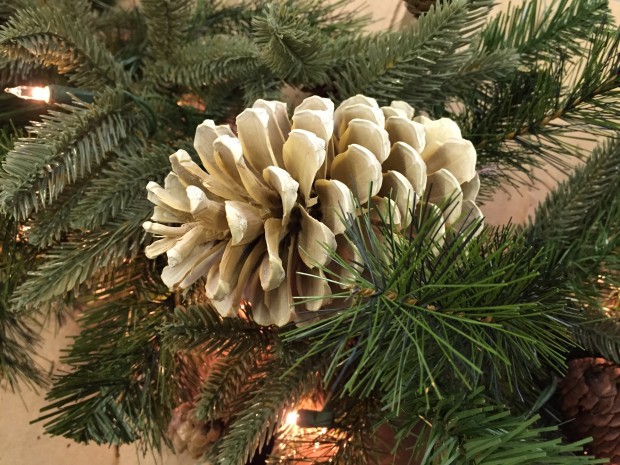 These bleached pine cones that so enchanted me this season sparked an interest in the cone world. Although pine cones are as familiar to me as the back of my hand, I realized that I did not know so much about them. These woody structures house the reproductive mechanism of a conifer. The female pine cones are large, and produce seeds. The male cones are small, produce lots of pollen, and eventually disappear once the pollen is dispersed. Of great interest to me is the fact that the identification of many pines revolves around the particulars of the cones they produce. The conifers existed on earth long before any flowering plant. These cones are considered the precursors of flowers. No wonder gardeners prize them.
These bleached pine cones that so enchanted me this season sparked an interest in the cone world. Although pine cones are as familiar to me as the back of my hand, I realized that I did not know so much about them. These woody structures house the reproductive mechanism of a conifer. The female pine cones are large, and produce seeds. The male cones are small, produce lots of pollen, and eventually disappear once the pollen is dispersed. Of great interest to me is the fact that the identification of many pines revolves around the particulars of the cones they produce. The conifers existed on earth long before any flowering plant. These cones are considered the precursors of flowers. No wonder gardeners prize them.
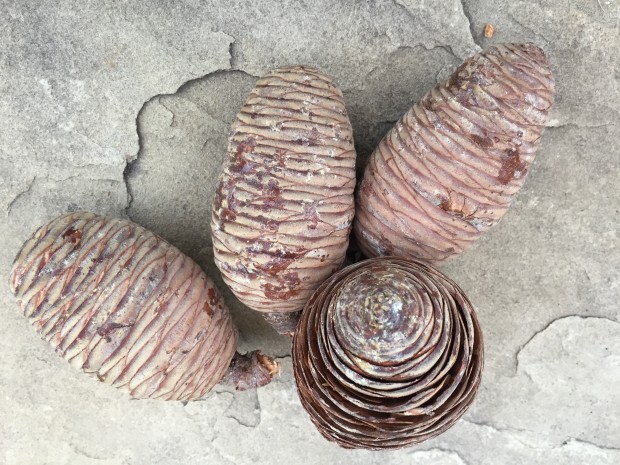 These cedar pine cones may have lived on a cedar through more than one season. It takes time for a cone to mature, and drop its seed. Once the cone has done has produced and dropped its seed, its biological directive has been fulfilled. The cones then drop to the ground. I spent some time today looking at these cones. I had never really taken the time to study on them them before. How incredibly beautiful they are.
These cedar pine cones may have lived on a cedar through more than one season. It takes time for a cone to mature, and drop its seed. Once the cone has done has produced and dropped its seed, its biological directive has been fulfilled. The cones then drop to the ground. I spent some time today looking at these cones. I had never really taken the time to study on them them before. How incredibly beautiful they are.
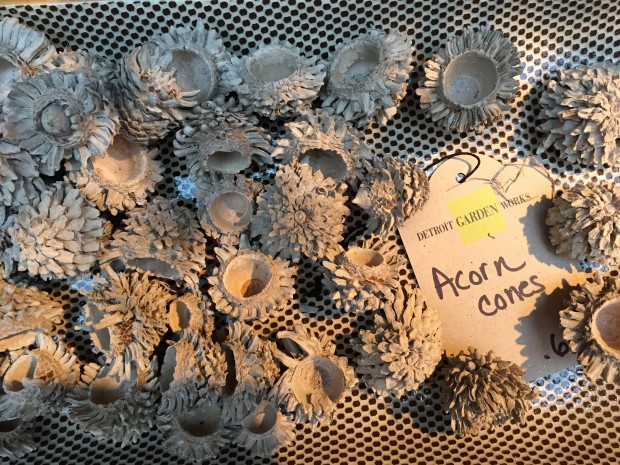 The oak acorn caps are not truly cones, but they share the woody and highly textured appearance of a pine cone. It was easy to like these acorn caps. Once the pine cones mature and drop, they are very persistent. A coulter pine produces the largest pine cones in the world. I have one that is over 20 years old. It has not deteriorated in the least bit. It is as heavy as a rock, and as architectural as the most beautiful building in the world.
The oak acorn caps are not truly cones, but they share the woody and highly textured appearance of a pine cone. It was easy to like these acorn caps. Once the pine cones mature and drop, they are very persistent. A coulter pine produces the largest pine cones in the world. I have one that is over 20 years old. It has not deteriorated in the least bit. It is as heavy as a rock, and as architectural as the most beautiful building in the world.
 How pine cones came to be associated with the holiday and the garden season’s end, I have no idea. But they have adorned many a wreath and garland. A bowl full of these ponderosa pine cones would be simply beautiful. We are able to purchase pine cones which have picks attached. This makes them easy to use in decorations. We also attach them via wire that is wrapped around the scales. Pine cones with tight scales-such as these cones-may need to be drilled. Having done this, I am amazed at how hard and dense their wood it. Plan for some drilling time.
How pine cones came to be associated with the holiday and the garden season’s end, I have no idea. But they have adorned many a wreath and garland. A bowl full of these ponderosa pine cones would be simply beautiful. We are able to purchase pine cones which have picks attached. This makes them easy to use in decorations. We also attach them via wire that is wrapped around the scales. Pine cones with tight scales-such as these cones-may need to be drilled. Having done this, I am amazed at how hard and dense their wood it. Plan for some drilling time.
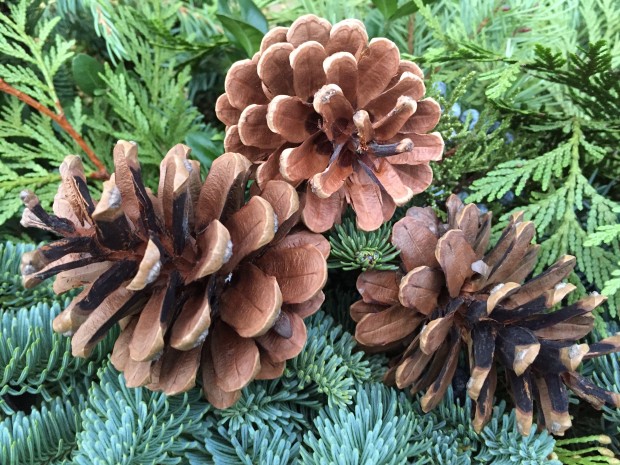 These cones are produced by pinus nigra. From the front, the scales are a rich cinnamon brown. From the side or back, the cones are black.
These cones are produced by pinus nigra. From the front, the scales are a rich cinnamon brown. From the side or back, the cones are black.
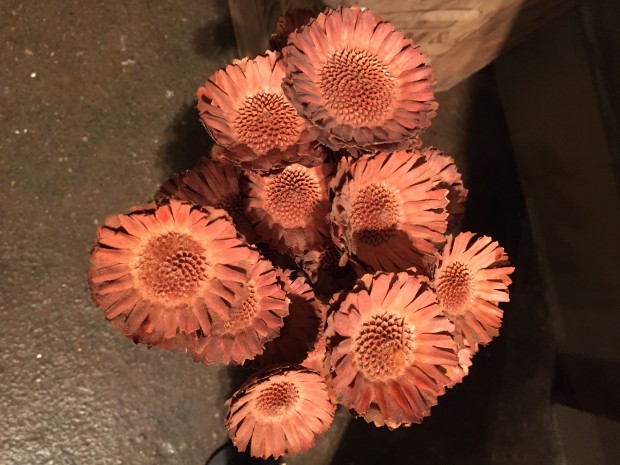 These dried “flowers” were made from the base of a pine cone.
These dried “flowers” were made from the base of a pine cone.
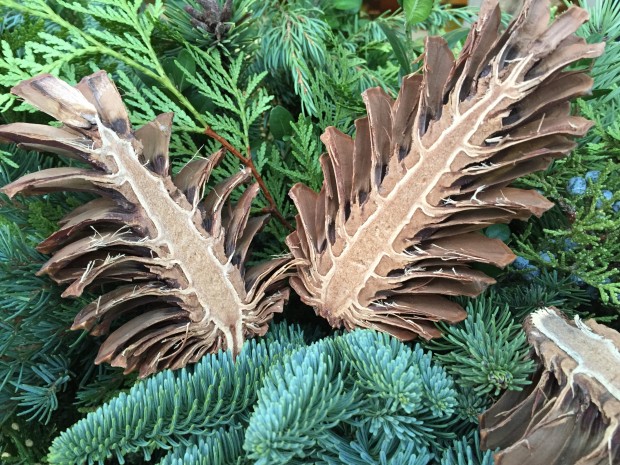 These half pine cones come from pinus maritima. Pine cones split in half are great for places where a full cone would be too wide. This picture of the split side illustrates the density and strength of the cone.
These half pine cones come from pinus maritima. Pine cones split in half are great for places where a full cone would be too wide. This picture of the split side illustrates the density and strength of the cone.
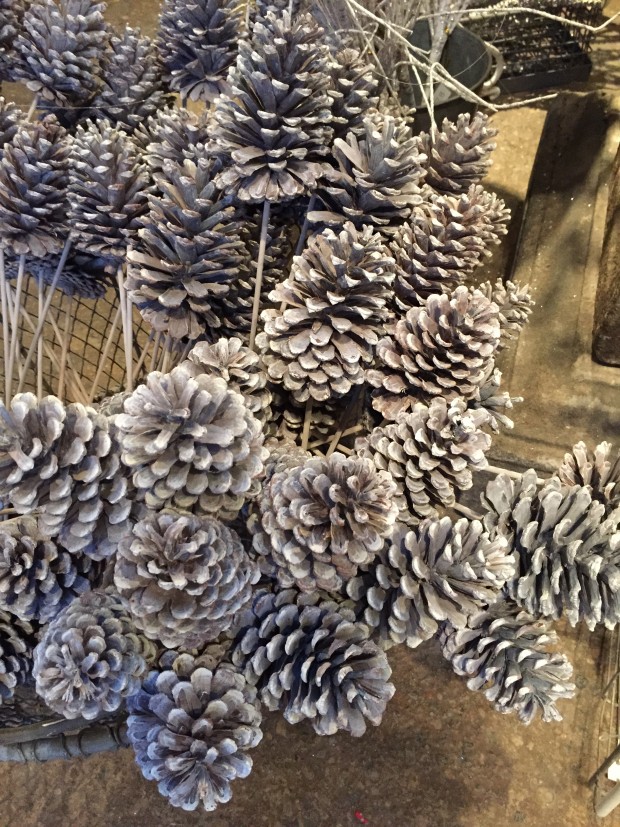 We carry many species of pine cones for the winter season. Some are native to our zone. Others come from places far away, and have that exotic look. These pine cones have had a gray wash applied to them. They can take paint as well as any piece of wood furniture.
We carry many species of pine cones for the winter season. Some are native to our zone. Others come from places far away, and have that exotic look. These pine cones have had a gray wash applied to them. They can take paint as well as any piece of wood furniture.
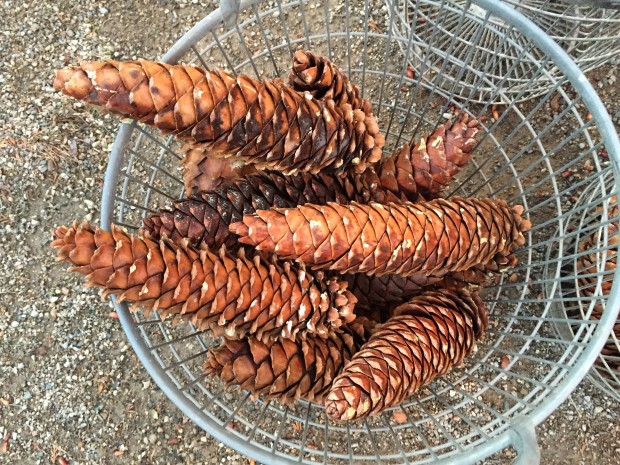 Sugar pine cones rank among the longest cones in the world. They regularly grow to 24″ long. Thy are sold by their length. The long cones are especially prized. The scales are tight, when they are fresh harvested. With age, those scales expand and flair out. A pine cone is a very familiar object indeed. But it is an enduring object whose appeal never fades.
Sugar pine cones rank among the longest cones in the world. They regularly grow to 24″ long. Thy are sold by their length. The long cones are especially prized. The scales are tight, when they are fresh harvested. With age, those scales expand and flair out. A pine cone is a very familiar object indeed. But it is an enduring object whose appeal never fades.
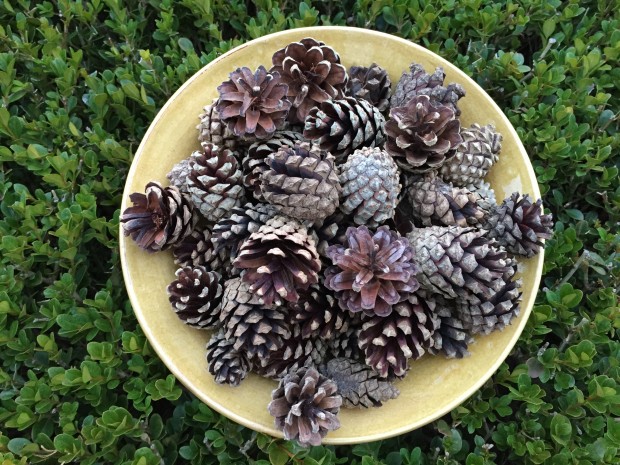 a bowl of cones from pinus sylvestris
a bowl of cones from pinus sylvestris
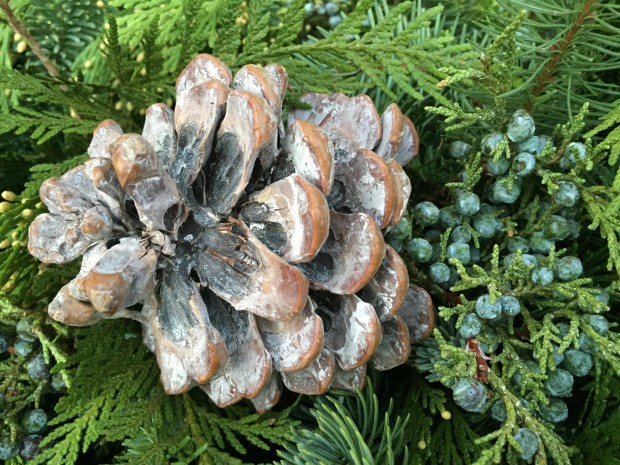 a cone whose species is unknown to me
a cone whose species is unknown to me
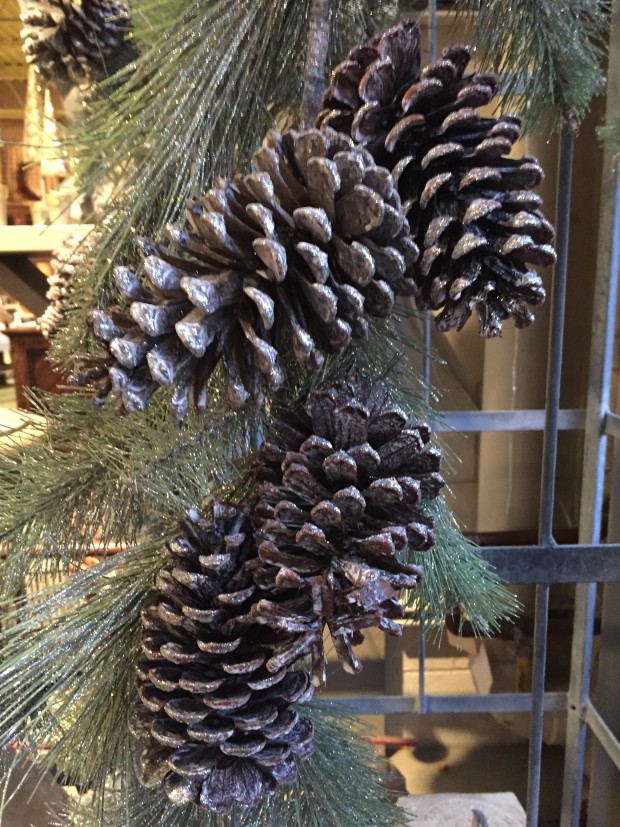 These natural cones have been attached to an artificial garland, and sprayed with sparkle. I feel sure that they will endure as long as the garland. As in just about forever. Just about forever-that surely describes every gardeners relationship with the natural world.
These natural cones have been attached to an artificial garland, and sprayed with sparkle. I feel sure that they will endure as long as the garland. As in just about forever. Just about forever-that surely describes every gardeners relationship with the natural world.

Thank you so much for the tutorial on pine cones. I love them too, and collect them off our own trees, and keep the ones on the wreaths I purchase every year. I heap them in bowls in the house with glowing LED mini lights and shiny ornaments, stuff them into the greens in my small hay manger window planters and when they finally begin to deteriorate, use them as fire starters in the fireplace. I love your bleached cones- how is it done?
Also, I love your blog posts and have used many of your ideas for my own displays- you are an inspiration! Happy Holidays. Lynn
Dear Lynn, I do not know the process for the bleached pine cones. Happy holidays to you! all the best, Deborah
Surely one can assumed the connection between cones and the holidays is that they represent the “first” conifer ornaments.
Thanks for your articulate and inspired writing and diligence to your blog.
Happy Holidays all.
interesting post deborah. you have brought to me a new appreciation for these ornaments of nature.
merry christmas to you
debra
On the Stone Gable blog, she gives a recipe for the bleached cones. Thank you so much for all I have learned and enjoyed from your site.
I love all your posts! You have so many beautiful ideas! The pine cone you said is unknown to you is shown with juniper fronds and berries. Thanks for all the info.
Sharon
I love all the different pine cones and I too use them for the Christmas wreaths I make and sell in Dorset / England. My neighbour has rather a large pine tree and occasionally a very large pine cone drops my side ! I put them by our fire and with the heat they open up.
Happy Christmas !
Rebecca
This was fascinating,Deborah, thanks. Janet
These photos are amazing, would you mind telling me about the camera and lighting that you use. Thanks Betsy
Dear Deborah,
Thank you for the generous gifts of garden-related inspiration, instruction and enthusiasm you bring to us throughout the year. A new post from you in my inbox always makes for a splendid day!
All the way from Texas, we send our very best wishes to you and yours for a very Merry Christmas and a happy, healthy New Year!
Anne
Originally pine cones were brought inside to assure fruitfulness and luck in the household during long dark days.
They open in light and heat and close in dark and cold. They are often associated to the ” pineous ” section of the brain that we as mammals regulate our wake and sleep hours.
I researched them as I make them of ceramics and fire them in salt and wood kilns
Would you like to see images of them? Let me know.
Dear Kim, thanks for the information-very interesting. Yes, I would like to see images. all the best, Deborah
Your emails are the only ones I get excited about. ..thanks for sharing so graciously.
You have an interesting collection of cones. I tend to pick them up from our travels. Fun to have them.